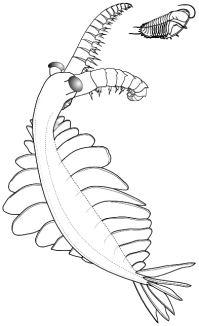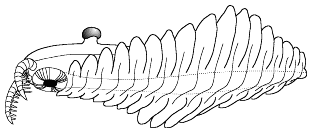 A dark reconstruction of Anomalocaris canadensis
cruising above the ocean floor captures the essence of the sleek, swimming
hunter. The eyestalks are swiveled forward, checking the floor ahead for
prey
A dark reconstruction of Anomalocaris canadensis
cruising above the ocean floor captures the essence of the sleek, swimming
hunter. The eyestalks are swiveled forward, checking the floor ahead for
prey
|

The combination of physical model photographed against
a real marine setting is effective here. The reconstruction depicts the swimming
lobes as dorsal features, which does not match the fossil evidence. Neither
does the strong overlap between the last swimming lobes and the fantail.
|
 This pen and ink rendition of Laggania cambria does
justice to the fossil specimens by showing ventral swimming lobe placement.
The sweep of the curve of the body is quite attractive, as is the tilted orientation
of the scene. Although the depiction of a distinct "head" matches that of
Whittington and Briggs (1985), the fossils specimens of Laggania really don't
show such a strong separation.
This pen and ink rendition of Laggania cambria does
justice to the fossil specimens by showing ventral swimming lobe placement.
The sweep of the curve of the body is quite attractive, as is the tilted orientation
of the scene. Although the depiction of a distinct "head" matches that of
Whittington and Briggs (1985), the fossils specimens of Laggania really don't
show such a strong separation.
|

This rendition of Laggania cambria as a fast-moving
swimmer shows a dorsoventrally flattened animal that is streamlined for swimming.
The sine-wave of swimming movements along the lateral lobes is clearly shown.
The animal almost has a squid-like demeanor.
|
 This small image of Anomalocaris chomping on a trilobite
depicts the swimming lobes as independent, wing-like flaps, each capable of
movment.
This small image of Anomalocaris chomping on a trilobite
depicts the swimming lobes as independent, wing-like flaps, each capable of
movment.
 The same model as the image above, but in a larger, swimming
depiction, suggests that there was dorsal segmentation, which is possible,
not clearly shown in fossil specimens. The imbrication of the tail lobes seems
correct, and the angled depiction effectively avoids the problem of whether
the fantail overlapped with the segments bearing the last pairs of swimming
lobes.
The same model as the image above, but in a larger, swimming
depiction, suggests that there was dorsal segmentation, which is possible,
not clearly shown in fossil specimens. The imbrication of the tail lobes seems
correct, and the angled depiction effectively avoids the problem of whether
the fantail overlapped with the segments bearing the last pairs of swimming
lobes.
|

This image, as if taken hovering just above the surface
of the Cambrian ocean, shows a red-eyed Anomalocaris cruising just below
the surface. Once againm dorsal segmentation is apparent, and the artist
chose to depict the dorsal fantail as independent of the swimming lobes.
|
 Sometimes the artistic renditions get quite imaginative
and bright. This anomalocarid is not a match for any known species, but Laggania
is probably the inspiring taxon. The fins are dorsally placed, which is a
problem, but I like the fluorescent mouth, and the bright color patterns.
Sometimes the artistic renditions get quite imaginative
and bright. This anomalocarid is not a match for any known species, but Laggania
is probably the inspiring taxon. The fins are dorsally placed, which is a
problem, but I like the fluorescent mouth, and the bright color patterns.
|
 A pair of Laggania cruise the Burgess cliffs in this
depiction: a good match for the Whittington & Briggs 1985 reconstruction.
One of the reasons Laggania is popular with computer artists is that
the different body parts can be constructed readily using simple, geometric
"primitives" (basic shapes without much complex topology), then combined
and posed at will.
A pair of Laggania cruise the Burgess cliffs in this
depiction: a good match for the Whittington & Briggs 1985 reconstruction.
One of the reasons Laggania is popular with computer artists is that
the different body parts can be constructed readily using simple, geometric
"primitives" (basic shapes without much complex topology), then combined
and posed at will.
|
 My rendition of Anomalocaris canadensis,
created in Macromedia Freehand, captures a concept of the animal as an active
and acrobatic swimmer, able to capture evasive swimming prey. The swimming
lobes are ventral, and the dorsal fantail follows the last pa
My rendition of Anomalocaris canadensis,
created in Macromedia Freehand, captures a concept of the animal as an active
and acrobatic swimmer, able to capture evasive swimming prey. The swimming
lobes are ventral, and the dorsal fantail follows the last pa
ir of swimming lobes.
|

In contrast, I depict Laggania
as a sweep-feeding planktivore, that moves through the well-lit upper waters,
raking in small swimming creatures, much as manta rays and whale-sharks do
today. In ecological thought, the partitioning of trophic guilds by two species
of anomalocarids in this manner would allow for their coexistence without
much competition.
|

|
I end this page with an image I created of two Anomalocaris
canadensis converging on an Olenoides trilobite. This doesn't
necessarily imply that they engaged in cooperative hunting. The second Anomalocaris
could have merely been attracted to the commotion caused by the activities
of the other. It would be interesting to consider what kinds of agonistic
behaviors occurred between individuals, and whether they engaged in any specialized
territorial or courtship behaviors.
|










